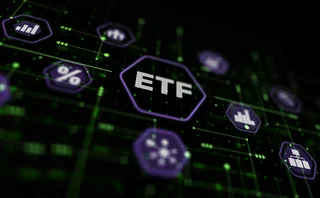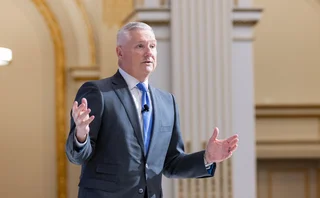Alliances and experiments: Trading firms get innovative in 2023
Rebecca offers a recap of the year's most notable technology use-cases led by sell-side and buy-side institutions.

I’m not sure about you, but to me, this year has felt both 10 years and 10 minutes long—a lot has happened. I moved from New York to London and our editor-in-chief, Anthony Malakian, trusted me to manage three fantastic reporters. I somehow have to not screw them up. But as the old adage goes, hopefully I “fail fast”—something that I’m sure a few of the firms I’ll mention here can relate to.
The first story I wrote this year, “Brown Brothers Harriman unifies busy suite of AI products,” was a case study in uniting a series of disparate AI-powered applications that the bank had been building before and during the Covid pandemic—and all the lessons learned and pivots taken along the way.
Kevin Welch, who heads up workforce transformation disciplines within BBH’s Investor Services division, told me at the time, “We’re thinking about the art of the possible.” And this year, the definition of “what’s possible” expanded for institutions who inked flashy partnerships with cloud providers, explored generative AI, reached for quantum advantage, or jumped in on fixed-income electronification.
Here are some of the most notable cases of end-user innovation we’ve covered in 2023:
- Citadel Securities, Jane Street battle fixed-income connectivity challenges with MultiLynq buy-in
Market-maker Citadel Securities and quant trading firm Jane Street invested undisclosed amounts into MultiLynq, a provider of connectivity to the growing number of electronic trading venues in fixed-income markets.
“Fixed income is still an emerging asset class for electronification, and the technology is not as uniform as it could be. So, when we have to develop to multiple venues—and more venues are emerging every year in the fixed-income space—it involves a lot of resources,” Troy Kane, global head of derivatives and Fixed Income Clearing Corporation (FICC) at Citadel Securities, told WatersTechnology in May. Kane is responsible for managing the relationships with many of the venues that Citadel currently trades on or is looking to build relationships with.
With MultiLynq, these connections that normally take firms lots of time and effort to build themselves can be done through the vendor’s single API.
Citadel began its foray into fixed income by establishing and managing its own connectivity to the major venues, such as Tradeweb and Bloomberg. But as more venues came to market, it realized that connecting to them all—and maintaining and updating those connections over time—would prove onerous, even for a firm with the size and resources of Citadel. To add access to other markets without adding complexity, the firm enlisted MultiLynq, becoming one of the vendor’s first clients.
- Citi’s internal cloud project gets open-sourced
A couple of years ago, Citi embarked on a mission to sharpen its cloud strategy by ensuring its concentration risk was mitigated by being able to operate on multiple cloud infrastructure platforms. Jim Adams, CTO and head of technology infrastructure at Citi, said the bank quickly found that there was “an awful lot” of complexity and cost associated with replicating the controls needed by a highly-regulated firm.
Internally, Citi created a model that would describe the logical controls that would address threats faced by security gaps made by multi-cloud implementations.
Citi’s initiative eventually set groundwork for the Fintech Open Source Foundation’s Common Cloud Controls project, an open standard to describe common controls across public cloud providers in the financial services sector.
The project is looking to provide a consistent approach to how the threats that a service must mitigate are described. “A CSP can then contribute and give us the implementation details of their controls that would match that logical control that would address that threat,” Adams said. One provider might say there is a single control that they can use, while another may have two or three. The expectation is that the providers will be able to map to the standard.
Recognizing that threats change over time, participants—which include Citi, Goldman Sachs, Morgan Stanley, Bank of Montreal, Royal Bank of Canada, and London Stock Exchange Group—have created this baseline, knowing that there will still be ongoing work and likely more advanced versions of the standard.
- LSEG, Symphony vie to create a ‘LinkedIn’ for capital markets
Working separately, the London Stock Exchange Group and chat and collaboration vendor Symphony are racing against one another to create a trusted directory for the financial services industry.
The most apt comparison to make is that these companies are looking to build a platform that’s functionally similar to LinkedIn—a directory of professional users. While LSEG and Symphony have chafed at the suggestion of operating a social media platform, social media has inspired and informed both of their plays.
LSEG indicated that the potential endgame of its 10-year deal announced last year with tech giant Microsoft, which owns the real LinkedIn, could be this in part. Symphony, on the other hand, began executing this plan after the 2021 appointment of its second CEO, Brad Levy, who has added new features to the vendor’s offering including identity management and know-your-customer services.
- BNY Mellon deploys AI, cloud tools to back-office analytics needs
Custodian bank BNY Mellon is applying AI to use-cases such as predicting settlement failures, translating client payment instructions, and data wrangling and distribution.
Mike Demissie, head of digital assets and advanced solutions at BNY Mellon, told WatersTechnology that the bank was looking to apply emerging technologies to areas that are industry problems—such as settlement fails and data science needs—at scale.
With that in mind, BNY Mellon’s team spent the last five years building Data Vault, its cloud-native data platform. Built on Microsoft Azure and powered by Snowflake, it is designed to help users rapidly collect, connect, store and distribute data across an organization.
Mark McKeon, CEO for data and platform solutions at BNY Mellon, said that rather than the bank thinking about integrating data, it’s now focused on sharing data in real time. “It’s not taking a snapshot at a certain point and then moving it over to a different provider. Everyone’s working off this common dataset,” he says.
He added that over the past few years, service providers like BNY Mellon, BlackRock’s Aladdin, other trading platform vendors, and data providers are finding it more challenging to work independently of each other.
“There’s been this kind of acknowledgment or recognition that everybody can do better if there is this kind of interoperability and integration and partnerships,” he says.
- Goldman Sachs looks to ‘Amazon’-like ecosystem with MarketView launch
Chris Churchman describes MarketView, a new visual analytics dashboarding ecosystem by Goldman Sachs, as his baby. Churchman, head of Goldman Sachs Marquee, joined the firm in July 2021 and started filing patents for MarketView shortly thereafter. MarketView is available through the bank’s Marquee platform and provides visual insights developed by Goldman Sachs’ researchers.
Churchman sees MarketView as similar to Amazon. Clients can access the analytics Goldman has generated from a vendor’s data and, if they choose, opt to buy that data themselves. The platform is prepopulated with a series of charts and widgets created by Goldman’s research team. Users with a subscription can create their own. The accompanying mobile app presents like an Instagram feed, where traders can scroll through the widgets.
“You might not always only trade with Goldman, but we want to be in the loop every time,” Churchman says. After a client uses MarketView to design their investment thesis and begins to decide what and who to trade with, Churchman explains, “Goldman should be one of the counterparties you ask because we’ve helped you with that.”
- Millennium Management enlists Google for building custom tech solutions
Multi-strategy hedge fund Millennium Management selected Google Cloud for its portfolio managers to leverage AI tools such as Vertex AI and data analytics via BigQuery in a multi-cloud environment.
“Millennium has been an early adopter of cloud technology, and by offering access to the Google Cloud infrastructure, we are providing portfolio managers and technologists with optionality in cloud capabilities. We will continue to explore new ways cloud can add value to our firm, including expanding our generative AI capabilities,” said Rob Newton, global head of technology infrastructure at Millennium.
In addition to the proprietary technology deployed to Millenium’s investment teams, the firm began building out its cloud capabilities in 2016. It also counts AWS as a provider of cloud services and machine learning through the firm’s use of SageMaker.
- What is Aladdin Trader? BlackRock’s fixed-income tool still a mystery
BlackRock occupies a unique position in the capital markets. As both the largest asset manager globally and a major vendor of technology services through its portfolio and order management system Aladdin, it is both user and provider.
A WatersTechnology investigation over the course of 18 months revealed the existence of a mystery tool, Aladdin Trader, believed to be similar to an execution management system built into the OMS.
BlackRock did not respond to a list of questions and declined to comment. So, it’s not clear what stage the project is at, or what BlackRock’s ultimate vision is. Oddly enough, BlackRock mentioned Aladdin Trader for this year’s WatersTechnology Buy-Side Technology Awards, saying that “users can now directly engage with counterparties by leveraging native fixed-income order and execution management functionality embedded within Aladdin.”
Aladdin does not currently offer a standalone execution management system, and the company has not said that it plans to create one. Rather, the platform has built-in bespoke execution tools and has partnerships with third-party EMS providers. But sources who have either seen Aladdin Trader or who have heard about it say that it will build upon Aladdin’s current execution functionality, though it might toe the line of being an actual EMS.
- Banks find intriguing ‘data play’ via tokenization efforts
At a time where the traditional finance system is still a bit iffy on crypto and blockchain technology, custodian banks such as State Street, Northern Trust, and BNY Mellon are among the most tech-forward when it comes to digital assets and the potential benefits to be derived from them.
The US Securities and Exchange Commission recently issued guidance that markedly differentiated virtual assets, or crypto, from digital assets, but some major financial players are getting experimental on the latter asset class.
Aside from the usual benefits espoused by proponents—increased liquidity, enhanced transparency, immutability, the same attributes that harken back to early blockchain zeal—Northern Trust’s Justin Chapman said the main tokenization use case—which it has applied to fixed-income securities, private equity, and carbon credits thus far—for the organization is a data management one.
Take, for instance, the bond market. With a tokenized asset, relevant data to the asset class and the asset itself can be programmed into the token at issuance, including benchmark data, credit ratings, and ESG scores, said Chapman, who leads the bank’s Digital Assets and Financial Markets group.
However, industry resistance to and distrust of blockchain-based applications remain a hurdle to be overcome for proponents.
Jay Biancamano, head of digital commercialization at State Street, says that on a recent industry panel he participated in, he was asked the question, “Why hasn’t tokenization taken off yet?”
He replied that he doesn’t think that anyone doubts that tokenization can eliminate various processes, but the field has been hindered by the fact that one single use-case, or focus, hasn’t emerged as a major incentive to implement it. As a result, disparate experiments and projects in many corners of finance have made blockchain a jack of all trades and a master of none.
Only users who have a paid subscription or are part of a corporate subscription are able to print or copy content.
To access these options, along with all other subscription benefits, please contact info@waterstechnology.com or view our subscription options here: http://subscriptions.waterstechnology.com/subscribe
You are currently unable to print this content. Please contact info@waterstechnology.com to find out more.
You are currently unable to copy this content. Please contact info@waterstechnology.com to find out more.
Copyright Infopro Digital Limited. All rights reserved.
You may share this content using our article tools. Printing this content is for the sole use of the Authorised User (named subscriber), as outlined in our terms and conditions - https://www.infopro-insight.com/terms-conditions/insight-subscriptions/
If you would like to purchase additional rights please email info@waterstechnology.com
Copyright Infopro Digital Limited. All rights reserved.
You may share this content using our article tools. Copying this content is for the sole use of the Authorised User (named subscriber), as outlined in our terms and conditions - https://www.infopro-insight.com/terms-conditions/insight-subscriptions/
If you would like to purchase additional rights please email info@waterstechnology.com
More on Trading Tech
This Week: BBH, AllianceBernstein add data solutions, Deutsche Börse-Nodal Exchange, and more
A summary of some of the latest financial technology news.
Consortium backs BGC’s effort to challenge CME
Banks and market makers—including BofA, Citi, Goldman, Jump and Tower—will have a 26% stake in FMX.
Symphony boosts Cloud9 voice offerings with AI
The messaging and collaboration platform builds on Cloud9’s capabilities as it embraces the AI wave in what CEO Brad Levy calls “incremental” steps.
Can exchanges leverage new tech to claw back ETF share from RFQ platforms?
Systematic trading strategies and proliferating data are bringing efficiency to an otherwise-fragmented European ETF market.
Nasdaq reshuffles tech divisions post-Adenza
Adenza is now fully integrated into the exchange operator’s ecosystem, bringing opportunities for new business and a fresh perspective on how fintech fits into its strategy.
Liquidnet sees electronic future for gray bond trading
TP Icap’s gray market bond trading unit has more than doubled transactions in the first quarter of 2024.
This Week: HKEx's new derivatives platform; GoldenSource; Quonian-SimCorp, and more
A summary of some of the latest financial technology news.
Chris Edmonds takes the reins at ICE Fixed Income and Data Services
Edmonds is now leading ICE’s fixed income and data business as the rush to provide better data and analytics in fixed income builds.
Most read
- Chris Edmonds takes the reins at ICE Fixed Income and Data Services
- Deutsche Börse democratizes data with Marketplace offering
- Nasdaq reshuffles tech divisions post-Adenza








